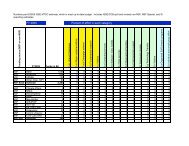Ground Truth Studies Teacher Handbook - Aspen Global Change ...
Ground Truth Studies Teacher Handbook - Aspen Global Change ...
Ground Truth Studies Teacher Handbook - Aspen Global Change ...
Create successful ePaper yourself
Turn your PDF publications into a flip-book with our unique Google optimized e-Paper software.
A <strong>Global</strong> <strong>Change</strong> Primer (continued)<br />
wonder chemicals. The chlorine from CFCs, and the bromine from halons, destroy<br />
stratospheric ozone molecules, and each atom of these elements can destroy<br />
thousands of ozone molecules.<br />
The Ozone Hole<br />
In the 1970s, two scientists predicted that CFCs would cause a global decline in<br />
stratospheric ozone. Years later satellite sensors recorded a drop in ozone over<br />
Antarctica, and even flagged the lowest values, but the ozone levels were so low,<br />
they were outside the range the computers had been programmed to accept as valid<br />
data and so the early warning was missed. Looking back at the data revealed that in<br />
1984, the unsuspected ozone hole was already larger than the continental U.S. By<br />
1987, the average ozone concentration over the South Pole was down 50%; during<br />
springtime it was down 70%, and in some spots, had essentially disappeared<br />
altogether. By 1992, the ozone hole had grown in area to nearly three times the size<br />
of the continental U.S. Though scientists had predicted the global decline in<br />
stratospheric ozone, no one had anticipated that ozone loss would appear so<br />
dramatically and suddenly in the form of a “hole” in the ozone layer over Antarctica.<br />
1979<br />
1980<br />
1981<br />
1982<br />
< 390 DU<br />
< 240 DU<br />
Concentration<br />
< 240 DU<br />
< 390 DU<br />
If chlorine and bromine from CFCs and halons released from populated areas cause<br />
ozone destruction, then why is the ozone hole at the South Pole? The CFCs and<br />
halon sources are primarily from the mid-latitudes and after their release are<br />
transported by convection to the upper atmosphere and eventually the stratosphere.<br />
There are a couple of unique features that make the stratosphere over the poles<br />
particularly the South Pole more susceptible: First, Antarctica and the air above it<br />
is extremely cold and this leads to the formation of Polar Stratospheric Clouds<br />
(PSCs). Tiny ice crystals in PSCs provide chemically-active sites where the<br />
chlorine and bromine can catalyze the breakup of the ozone. The other feature is<br />
the polar vortex, a spiral of winds that swirls around the South Pole, isolating the<br />
Antarctic stratosphere during the winter and early Spring so the ozone destruction<br />
process goes on without Antarctic ozone being replenished by ozone rich air from<br />
lower latitudes.<br />
1983<br />
1984<br />
1985 1985<br />
<strong>Global</strong> Ozone Depletion<br />
But ozone losses are not confined to the South Pole. In 1988, over 100 international<br />
experts reported that the ozone layer around the entire globe was eroding much<br />
faster than anticipated. Between 1969 and 1986, the average global concentration<br />
of ozone in the stratosphere had fallen by approximately 2%. By 1991, losses of 6<br />
to 8% per decade had been measured at high latitudes (nearer to the poles) and<br />
Figure 7<br />
These pictures show the<br />
increase in size of the Antarctic<br />
ozone hole during successive<br />
winters. October monthly<br />
average TOMS total O 3<br />
. The<br />
crosses indicate South Pole.<br />
© ASPEN GLOBAL CHANGE INSTITUTE 1995 GROUND TRUTH STUDIES<br />
25


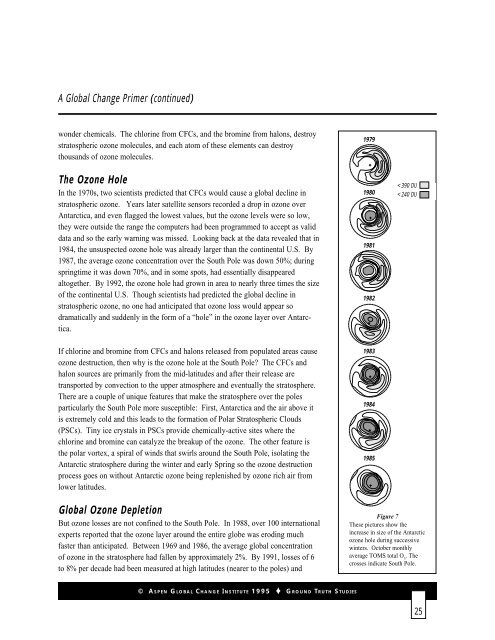
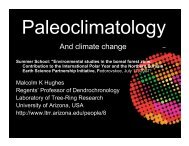


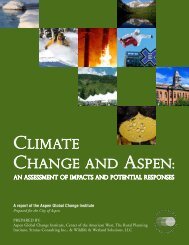

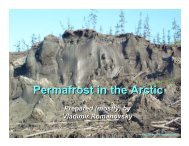
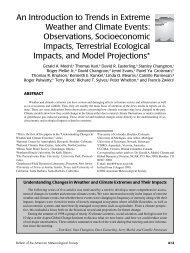
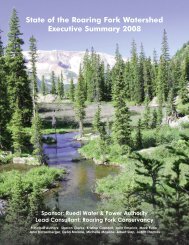
![View Powerpoint Slides [PDF]](https://img.yumpu.com/32486693/1/190x146/view-powerpoint-slides-pdf.jpg?quality=85)
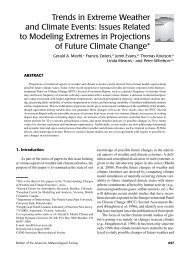

![View Powerpoint Slides [PDF]](https://img.yumpu.com/29411106/1/190x143/view-powerpoint-slides-pdf.jpg?quality=85)
